Introduction to Bone Broth Soup Recipe Chicken
Chicken bone broth soup is a nourishing and flavorful meal. It’s packed with nutrients from slow-cooked bones and fresh ingredients. Making your own bone broth adds depth and richness to the soup. This recipe is simple, versatile, and perfect for any season. Whether you want a comforting dinner or a healthy boost, this guide will show you how to make the best chicken bone broth soup from scratch. Let’s get started!

Why Make Chicken Bone Broth Soup?
Chicken bone broth soup is more than just a warm bowl of comfort—it’s a powerhouse of nutrition and flavor. Here’s why you’ll love making it at home:
Rich in Nutrients
Bone broth is loaded with collagen, amino acids, and minerals like calcium, magnesium, and phosphorus. These nutrients support joint health, gut function, skin elasticity, and overall immunity.
Deep, Natural Flavor
Simmering chicken bones slowly draws out intense, savory flavors. The result is a broth that’s richer and more flavorful than anything store-bought.
Great Use of Leftovers
Have a rotisserie chicken or leftover roast? Use the bones and scraps to create a delicious broth and stretch your ingredients further.
Customizable and Versatile
Bone broth soup is easily adaptable. Add noodles, vegetables, herbs, or spices to match your taste or dietary needs. You can make it light and clear, or hearty and filling.
Comfort Food with Health Benefits
This soup is ideal when you’re feeling under the weather or want something warm and soothing. It hydrates, heals, and satisfies—perfect for recovery or relaxation.
Budget-Friendly
Making your own broth from scraps saves money while reducing food waste. You get a high-quality soup for a fraction of the cost.

Key Ingredients and Equipment
Before you start cooking, it’s important to gather the right ingredients and tools. Each plays a vital role in building flavor and ensuring the soup turns out just right.
Essential Ingredients for Bone Broth
Chicken Bones
Use a whole chicken carcass, leftover rotisserie bones, or a mix of wings, drumsticks, and backs. The more joints and cartilage, the more collagen-rich your broth will be.
Cold Water
Start with cold water to help extract nutrients and flavor slowly and evenly during cooking.
Vegetables
Add aromatic vegetables like:
- Onions (quartered, skin on for color)
- Carrots (chopped, unpeeled)
- Celery (including leaves)
Garlic
Adds a savory depth—crush or slice before adding.
Apple Cider Vinegar
A small amount (1–2 tablespoons) helps draw minerals from the bones.
Bay Leaves, Peppercorns, and Herbs
These boost the aroma and complexity of the broth. Use fresh thyme, parsley stems, or rosemary as optional add-ins.
Salt (optional)
It’s best to salt the finished soup, not the broth, for better control.
Additional Ingredients for the Soup
Once the broth is made, you’ll build your soup with:
- Cooked Chicken: Shredded or chopped from your broth-making bones or fresh chicken.
- Vegetables: Such as carrots, peas, spinach, or zucchini.
- Noodles or Rice (optional): Egg noodles, brown rice, or orzo make the soup more filling.
- Fresh Herbs: Parsley, dill, or green onions add brightness before serving.
Recommended Equipment
Large Stockpot or Dutch Oven
At least 6–8 quarts in size, ideal for long, slow simmering.
Fine Mesh Strainer or Cheesecloth
For straining the finished broth to achieve clarity.
Tongs or Slotted Spoon
To remove bones and solids easily.
Ladle and Storage Containers
For serving and refrigerating or freezing leftovers.
Instant Pot or Slow Cooker (Optional)
These are great alternatives for hands-off cooking and faster results.
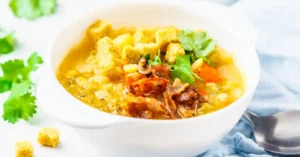
Key Ingredients and Equipment
Before you start cooking, it’s important to gather the right ingredients and tools. Each plays a vital role in building flavor and ensuring the soup turns out just right.
Essential Ingredients for Bone Broth
Chicken Bones
Use a whole chicken carcass, leftover rotisserie bones, or a mix of wings, drumsticks, and backs. The more joints and cartilage, the more collagen-rich your broth will be.
Cold Water
Start with cold water to help extract nutrients and flavor slowly and evenly during cooking.
Vegetables
Add aromatic vegetables like:
- Onions (quartered, skin on for color)
- Carrots (chopped, unpeeled)
- Celery (including leaves)
Garlic
Adds a savory depth—crush or slice before adding.
Apple Cider Vinegar
A small amount (1–2 tablespoons) helps draw minerals from the bones.
Bay Leaves, Peppercorns, and Herbs
These boost the aroma and complexity of the broth. Use fresh thyme, parsley stems, or rosemary as optional add-ins.
Salt (optional)
It’s best to salt the finished soup, not the broth, for better control.
Additional Ingredients for the Soup
Once the broth is made, you’ll build your soup with:
- Cooked Chicken: Shredded or chopped from your broth-making bones or fresh chicken.
- Vegetables: Such as carrots, peas, spinach, or zucchini.
- Noodles or Rice (optional): Egg noodles, brown rice, or orzo make the soup more filling.
- Fresh Herbs: Parsley, dill, or green onions add brightness before serving.

Recommended Equipment
Large Stockpot or Dutch Oven
At least 6–8 quarts in size, ideal for long, slow simmering.
Fine Mesh Strainer or Cheesecloth
For straining the finished broth to achieve clarity.
Tongs or Slotted Spoon
To remove bones and solids easily.
Ladle and Storage Containers
For serving and refrigerating or freezing leftovers.
Instant Pot or Slow Cooker (Optional)
These are great alternatives for hands-off cooking and faster results.

How to Prepare Chicken Bone Broth Soup
Now that you have a rich, flavorful chicken bone broth, it’s time to turn it into a complete soup. This process is simple, customizable, and can be done in under 30 minutes once the broth is ready.
Ingredients for the Soup
- 4–6 cups chicken bone broth (homemade or high-quality store-bought)
- 1–2 cups cooked chicken, shredded or chopped (use the meat from your broth bones or fresh cooked chicken)
- 1 cup carrots, sliced
- 1 cup celery, chopped
- 1 small onion, diced
- 2 cloves garlic, minced
- 1–2 cups noodles or rice (optional, depending on preference)
- Salt and pepper, to taste
- Fresh herbs (parsley, dill, or thyme), for garnish
- Olive oil or butter, for sautéing vegetables
Step-by-Step Instructions
Step 1: Sauté the Aromatics
Heat 1 tablespoon of olive oil or butter in a large pot over medium heat. Add diced onions, carrots, and celery. Cook for 5–7 minutes, until softened. Add minced garlic and sauté for another 30 seconds.
Step 2: Add Broth and Simmer
Pour in the bone broth. Bring to a gentle boil, then reduce to a simmer. Cook for 10–15 minutes until vegetables are tender.
Step 3: Add Chicken and Optional Ingredients
Stir in the cooked chicken. If using noodles or rice, add them now and cook until tender.
(Tip: If you’re using pre-cooked grains or noodles, stir them in during the last few minutes to warm through without overcooking.)
Step 4: Season and Adjust
Taste the soup and season with salt and pepper. Add more broth or water if it’s too thick. Stir in a handful of chopped fresh herbs just before serving.
Make It Your Own
You can customize this soup based on what you have on hand:
Add greens like spinach or kale in the last few minutes. Include corn, peas, or zucchini for extra veggies. Spice it up with chili flakes, lemon juice, or a dash of hot sauce.
Serving Suggestion
Serve the soup hot with crusty bread, garlic toast, or a side salad. It also pairs wonderfully with a squeeze of lemon or a sprinkle of Parmesan cheese on top.
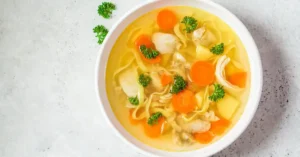
Variations and Substitutions
One of the best things about chicken bone broth soup is its flexibility. Whether you’re adapting it to dietary needs, using what you have in the kitchen, or craving a new flavor profile, there are countless ways to make this soup your own.
Flavor Variations
Classic Chicken Noodle Soup
Add wide egg noodles and a bit more broth for a nostalgic, comforting version. Finish with parsley for freshness.
Chicken and Rice Soup
Substitute noodles with white, brown, or wild rice. It’s hearty, gluten-free, and extra satisfying.
Shredded Chicken Verde Soup
Add tomatillo salsa, lime juice, and fresh cilantro for a tangy twist. Use shredded chicken and serve with tortilla strips.
Spicy Chicken Bone Broth Soup
Add chili flakes, jalapeños, or a splash of hot sauce. Great for clearing sinuses and warming up.
Creamy Chicken Bone Broth Soup
Stir in a splash of coconut milk or heavy cream at the end for a richer, silkier texture.
Vegetable Add-Ins
- Leafy greens: Add spinach, kale, or Swiss chard in the last 2–3 minutes.
- Starchy options: Add cubed potatoes or sweet potatoes for a heartier bowl.
- Seasonal vegetables: Zucchini, bell peppers, green beans, or mushrooms all work well.
Protein Swaps
- Turkey: Use leftover turkey in place of chicken, especially around the holidays.
- Tofu or chickpeas: For a vegetarian option (when using vegetable broth).
- Rotisserie chicken: A time-saver that adds rich flavor instantly.
Broth Substitutes
If you’re short on homemade bone broth:
- Use high-quality store-bought bone broth: look for organic, low-sodium versions with minimal ingredients.
- Use chicken stock or broth: less collagen-rich but still flavorful.
- Mix broth and water: to stretch a smaller quantity of homemade broth.
Gluten-Free, Dairy-Free, and Paleo Options
- Gluten-free: Use rice, gluten-free noodles, or potatoes instead of wheat-based noodles.
- Dairy-free: Stick with olive oil for sautéing and skip any cheese garnishes.
- Paleo: Avoid grains and legumes; load up on vegetables and use pasture-raised chicken.
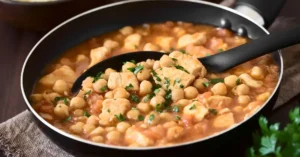
Top Tips for Perfect Bone Broth Soup
Want to take your chicken bone broth soup from good to exceptional? These tried-and-true tips will help you get deeper flavor, better texture, and more nutrition from every batch.
Use Joint-Rich Bones for Collagen
For a broth that gels when chilled (a sign of collagen), use bones with joints and connective tissue—like chicken wings, drumsticks, necks, and backs. The more joints, the richer and silkier your broth will be.
Add Apple Cider Vinegar Early
A splash (about 1 tablespoon) of raw apple cider vinegar helps extract minerals from the bones during the first few hours of simmering. Add it before cooking and let it sit for 20–30 minutes before turning on the heat.
Don’t Skip the Roast (if You Want More Flavor)
Roasting the bones and vegetables before simmering deepens the color and taste of your broth. It’s optional—but worth the extra step if you’re after a richer, more robust soup base.
Simmer Low and Slow
Low heat and long cooking (12–18 hours on the stovetop or slow cooker, or 2 hours in an Instant Pot) is key. Avoid rapid boiling—it can make your broth cloudy and reduce flavor clarity.
Skim Foam for a Clearer Broth
As your broth simmers, skim off any foamy scum that rises to the top with a spoon. This keeps your broth clear and clean-tasting.
Don’t Salt Until the End
Wait until your soup is fully cooked before adding salt. Broth reduces as it cooks, and salting too early may make it overly salty. Season in the final stages for better control.
Use Aromatics, But Don’t Overdo It
Onions, garlic, celery, carrots, bay leaves, and herbs are great, but too many strong-flavored ingredients (like too much garlic or rosemary) can overpower the broth. Keep it balanced.
Strain Thoroughly
Use a fine mesh strainer or cheesecloth for a smooth, clean broth. This step removes grit and small bone fragments.
Let It Cool Safely
Cool your broth quickly by transferring it to shallow containers or setting the pot in an ice water bath. Refrigerate or freeze within two hours to keep it safe and fresh.
Broth or Stock? What’s the Difference?
Bone broth is simmered long for maximum nutrients and collagen. Stock is cooked for a shorter time with bones and some meat—less gelatinous. Broth usually refers to meat simmered with vegetables, not necessarily bones.
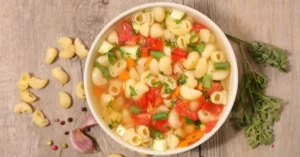
Serving Suggestions
A steaming bowl of chicken bone broth soup is satisfying on its own—but the right accompaniments can turn it into a complete and comforting meal. Whether you want to keep things simple or dress it up, here are some delicious ways to serve your soup.
Classic Pairings
Crusty Bread or Rolls
Serve with slices of warm sourdough, multigrain bread, or dinner rolls. Perfect for dipping into the rich broth.
Grilled Cheese Sandwich
Pair a hearty soup with a golden, melty grilled cheese for a classic comfort-food combo.
Side Salad
A crisp green salad with a light vinaigrette balances the warm, rich flavors of the soup.
Toppings and Garnishes
Enhance flavor and texture with simple toppings:
- Chopped fresh herbs (parsley, dill, cilantro)
- A squeeze of lemon or lime for brightness
- Grated Parmesan cheese for a savory, umami boost
- Crushed red pepper flakes for a touch of heat
- Toasted pumpkin seeds or croutons for crunch
Make It a Meal
Turn your soup into a complete meal by adding:
- A side of roasted vegetables
- Avocado slices (especially with spicier variations)
- Soft-boiled or poached egg for extra protein
- Cooked grains like farro, barley, or quinoa for added heartiness
Kid-Friendly Options
- Serve with buttered toast soldiers or crackers
- Add alphabet pasta or mini shells for fun and easy eating
- Blend the soup slightly for picky eaters who prefer smoother textures
Creative Serving Ideas
- In a bread bowl: Hollow out a round loaf and ladle in hot soup for a rustic presentation.
- Soup jars: Great for meal prep—layer cooked chicken, noodles, and veggies in a mason jar and pour in hot broth when ready to eat.
- With international flair: Serve with rice paper rolls, naan, or kimchi depending on the variation of your soup.

Storage, Freezing, and Meal Prep
One of the biggest advantages of chicken bone broth soup is that it stores and reheats beautifully. With a few simple techniques, you can make a big batch and enjoy it throughout the week—or freeze it for later. This section covers how to store, freeze, and prep your soup like a pro.
Storing in the Refrigerator
- Cool First: Let the soup cool to room temperature before refrigerating (no more than 2 hours after cooking to avoid bacteria growth).
- Use Airtight Containers: Transfer soup into sealed glass jars or BPA-free containers.
- Shelf Life: Properly stored, bone broth soup lasts up to 5 days in the refrigerator.
Tip: Store broth and solid ingredients (like noodles or rice) separately to keep textures fresh.
Freezing for Long-Term Storage
Best Containers:
- Freezer-safe glass jars (leave space at the top for expansion)
- Silicone molds or ice cube trays (great for portioning broth)
- Zip-top freezer bags (lay flat to save space)
Label & Date: Always label containers with the date and contents.
Shelf Life: Frozen chicken bone broth soup keeps well for 3 to 6 months.
Thawing Tips:
- Thaw overnight in the fridge
- Or place frozen container in a bowl of warm water for faster thawing
Reheating Instructions
- Stovetop: Reheat over medium-low heat until hot. Stir occasionally.
- Microwave: Heat in 1–2 minute intervals, stirring in between. Use a microwave-safe bowl.
- Avoid Boiling: Gentle reheating helps preserve nutrients and prevents overcooking ingredients.
Meal Prep Tips
- Batch Cook Bone Broth: Make a large quantity and freeze in small portions to use in soups, sauces, or grains throughout the week.
- Pre-Cook Add-Ins: Keep pre-cooked chicken, grains, and veggies in separate containers. Combine when ready to eat for optimal texture.
- Soup Jars or Lunch Containers: Assemble ready-to-heat soup bowls with chicken, vegetables, and herbs. Just add hot broth when ready to eat.
Pro Tips
- Don’t Freeze Noodles or Potatoes: They often turn mushy. Add them fresh when reheating if possible.
- Use Ice Cube Trays for Broth: Each cube is about 2 tablespoons—perfect for recipes that need a splash of flavor.
- Double the Recipe: It’s no extra effort and makes busy weeks so much easier.
Nutrition Information
Chicken bone broth soup isn’t just comforting—it’s also packed with essential nutrients that support overall wellness. Whether you’re sipping it for immune support, gut health, or simply as a light meal, each bowl offers a nutritious boost.
Nutritional Highlights (Per 1.5–2 cup serving)
Note: Values may vary depending on ingredients and portion size.
- Calories: 150–250 kcal
- Protein: 15–25g
- Fat: 5–10g (mostly healthy fats from chicken and broth)
- Carbohydrates: 10–20g (more if you add noodles or rice)
- Fiber: 1–3g (from vegetables)
- Sodium: 300–600mg (depending on salt and broth used)
- Collagen & Gelatin: Present in homemade bone broth (supports joints and skin)
Key Nutrients in Bone Broth Soup
Collagen & Gelatin
Supports joint health, skin elasticity, and gut lining repair. Homemade broth, especially from joint-rich bones, contains the most.
Amino Acids
Glycine, proline, and glutamine aid in digestion, muscle recovery, and detoxification.
Minerals
Rich in calcium, magnesium, potassium, phosphorus, and trace minerals—easily absorbed by the body thanks to long simmering.
Electrolytes
Helps maintain hydration, especially beneficial during recovery from illness or intense activity.
Immune-Boosting Compounds
Garlic, onions, and herbs contribute antioxidants and antimicrobial properties.
Diet-Friendly and Allergen Notes
- Gluten-Free: When made without pasta or with gluten-free grains/noodles
- Dairy-Free: As long as no cream or butter is added
- Low-Carb/Keto: Skip the noodles and use non-starchy vegetables
- Whole30/Paleo: Ensure all ingredients are compliant (especially store-bought broth)
- High-Protein: Especially with shredded chicken and gelatin-rich broth
Great for Special Diets and Lifestyles
- Weight Management: Low in calories but satisfying due to protein and volume
- Gut Health: The gelatin and amino acids support digestion and gut lining integrity
- Recovery: Ideal for post-illness or post-workout nourishment
- Fasting & Detox: Hydrating and nutrient-dense without being heavy
Conclusion
Chicken bone broth soup is the perfect blend of comfort, nutrition, and simplicity. With just a few wholesome ingredients and some simmering time, you can create a flavorful, nourishing soup that supports your health and satisfies your appetite. Whether you enjoy it as-is or customize it with your favorite add-ins, this timeless recipe is sure to become a go-to in your kitchen. Try it once—and you’ll keep coming back for more.
FAQS
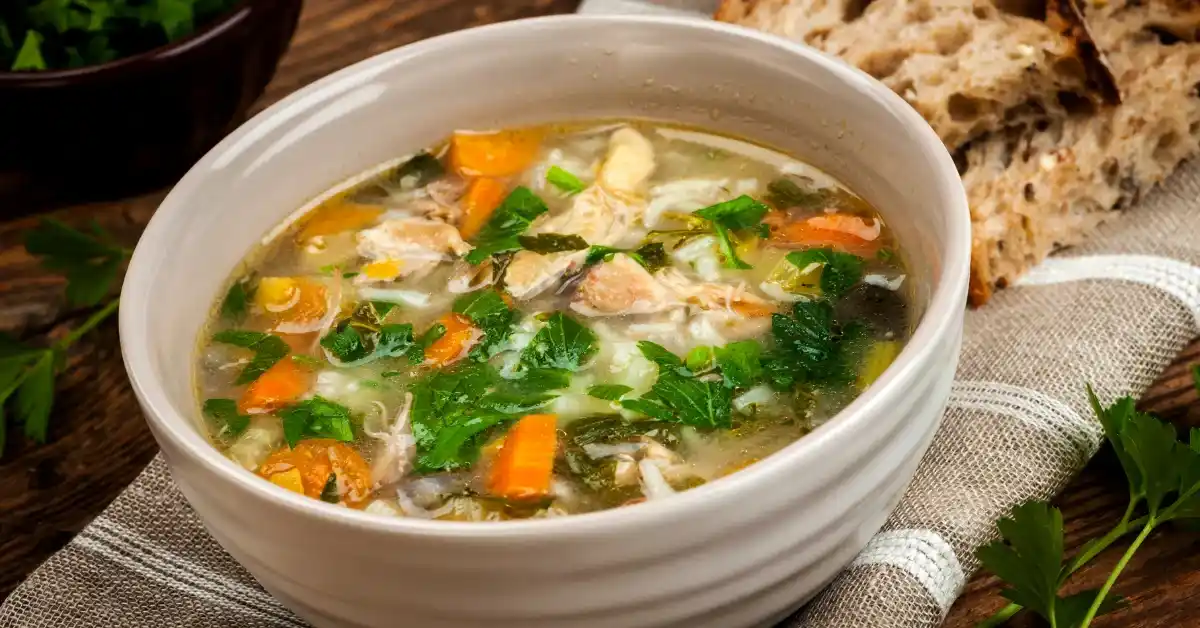
Bone Broth Soup Recipe Chicken
Ingredients
Method
- Heat olive oil in a medium Dutch oven or a stockpot with a thick bottom.
- Add carrots, celery and onions and cook on medium heat for 5-6 minutes, stirring often until softened.
- Add minced garlic cloves and all the spices. Stir and cook another minute until garlic is fragrant.
- Pour in chicken bone broth and 2 cups of water.
- Place the raw chicken breast (or thighs) in the pot and bring to boil.
- Cook on low partially covered for 30-40 minutes until the chicken is tender.
- Take the chicken out and cut into bite-sized pieces or shred with 2 forks or chop with a knife.
- Place the chicken back in the soup.
- Add cooked rice or noodles if desired.
- Taste and add more salt and pepper if needed.
- Serve hot sprinkled with chopped parsley leaves or dill.
